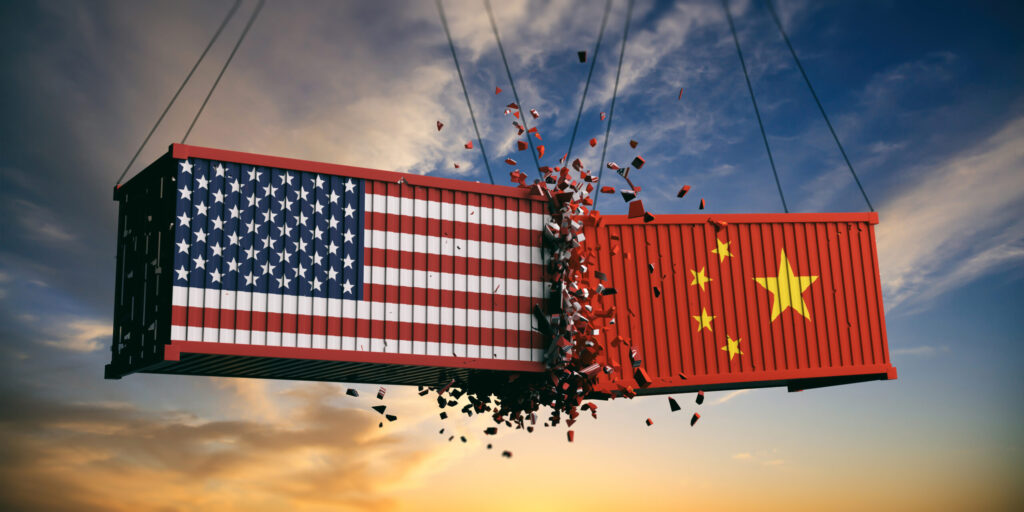 The global stock market’s steady march upward in 2019 was rather rudely interrupted in the last few days by an apparent breakdown in trade negotiations between the US and China. Until President Trump issued a tweet announcing a renewed interest in raising tariffs on some $200 billion of Chinese imports from 10% to 25%, the S&P 500 had climbed almost 18% since the start of the year. Initially, the news was largely ignored by financial markets, but stocks fell sharply on May 13 as President Trump followed through on his threat and China retaliated with tariff hikes on $60 billion of US imports. It now appears that a negotiated deal acceptable to both parties is unlikely to be reached in the near term. What are the implications for investors of a prolonged trade war with China, and by extension, with other countries that rely on trade with the United States?
The global stock market’s steady march upward in 2019 was rather rudely interrupted in the last few days by an apparent breakdown in trade negotiations between the US and China. Until President Trump issued a tweet announcing a renewed interest in raising tariffs on some $200 billion of Chinese imports from 10% to 25%, the S&P 500 had climbed almost 18% since the start of the year. Initially, the news was largely ignored by financial markets, but stocks fell sharply on May 13 as President Trump followed through on his threat and China retaliated with tariff hikes on $60 billion of US imports. It now appears that a negotiated deal acceptable to both parties is unlikely to be reached in the near term. What are the implications for investors of a prolonged trade war with China, and by extension, with other countries that rely on trade with the United States?
The financial media has been flooded with strategists, economists, and politicians all weighing in on the likely impacts of a lengthy trade war with China. From a purely mathematical point of view, the US economy is less vulnerable to a dramatic slowdown in trade with China than the Chinese economy is with us. At the current level of tariffs, consensus estimates are that the US likely to see a reduction in US GDP of about 0.2% this year, not enough to derail the longest expansion in US history. By virtue of their larger reliance on exports to the US, the hit to China’s GDP is likely to be larger, perhaps 0.5%. This calculation no doubt entered into the US’ decision to raise the ante on the dispute by instituting the higher 25% rate.
This estimate, however, fails to acknowledge the various, difficult-to-quantify spillover effects from the dispute. To name a few:
- How does the renewed uncertainty affect business investment decisions, both short- and long-term?
- What impact will higher consumer prices in the US have on spending, inflation, and consumer confidence?
- Will a slowing US economy cause the Fed to lower interest rates, or raise them because of tariff-induced price hikes?
- If Trump perceives that he is winning the trade war, is he likely to proceed with tariffs on the remaining $325 billion in Chinese imports, and/or possibly extend the levies to European autos?
- If the trade war drags on for a while, will supply chains be redirected away from China to lower cost countries? How might that impact China’s growth story?
Despite the rhetoric from the White House, most economists agree that tariffs act as a tax on economic activity and slow the rate of growth. Trump’s plan to “reimburse” farmers due to the loss of agricultural sales to China with tariff revenue is simply a redistribution of wealth from consumers and businesses (through higher prices) to the farmers who can’t sell as many soybeans to China any more. The net impact is a broad drag on consumer spending, the engine of US economic activity.
In the end, driving a hard bargain with China may ultimately be beneficial to the US by addressing intellectual property rights violations and relaxing some of the barriers to American companies from operating there. Some would argue that a more coordinated effort with other countries could impose more pressure on China to implement needed reforms without the damaging effects of a trade war. Whatever the outcome, both sides appear dug in at this point and unwilling to bend to accommodate the other side’s objectives.
Investor uncertainty raises risk premiums and heightens market volatility. That appears to be the immediate result of the breakdown in negotiations. At present, the relatively limited nature of the trade war is unlikely to shave more than a few tenths of a percentage point off global GDP, currently estimated by the IMF at 3.3% for 2019. However, an escalation of the dispute to include a larger number of goods and potentially other countries could have a much larger impact on global trade and financial markets. At the same time, a friendly tweet could end the standoff in an instant. Given the fluid nature of the discussions, we believe it would be unwise to make material portfolio adjustments at present. However, we will be carefully monitoring the status of these negotiations and their potential impact on investment strategy.
This report is the confidential work product of Ballentine Partners. Unauthorized distribution of this material is strictly prohibited.
The information in this report is deemed to be reliable but has not been independently verified. Some of the conclusions in this report are intended to be generalizations. The specific circumstances of an individual’s situation may require advice that is different from that reflected in this report. Furthermore, the advice reflected in this report is based on our opinion, and our opinion may change as new information becomes available.
Nothing in this presentation should be construed as an offer to sell or a solicitation of an offer to buy any securities. You should read the prospectus or offering memo before making any investment. You are solely responsible for any decision to invest in a private offering.
The investment recommendations contained in this document may not prove to be profitable, and the actual performance of any investment may not be as favorable as the expectations that are expressed in this document. There is no guarantee that the past performance of any investment will continue in the future.





